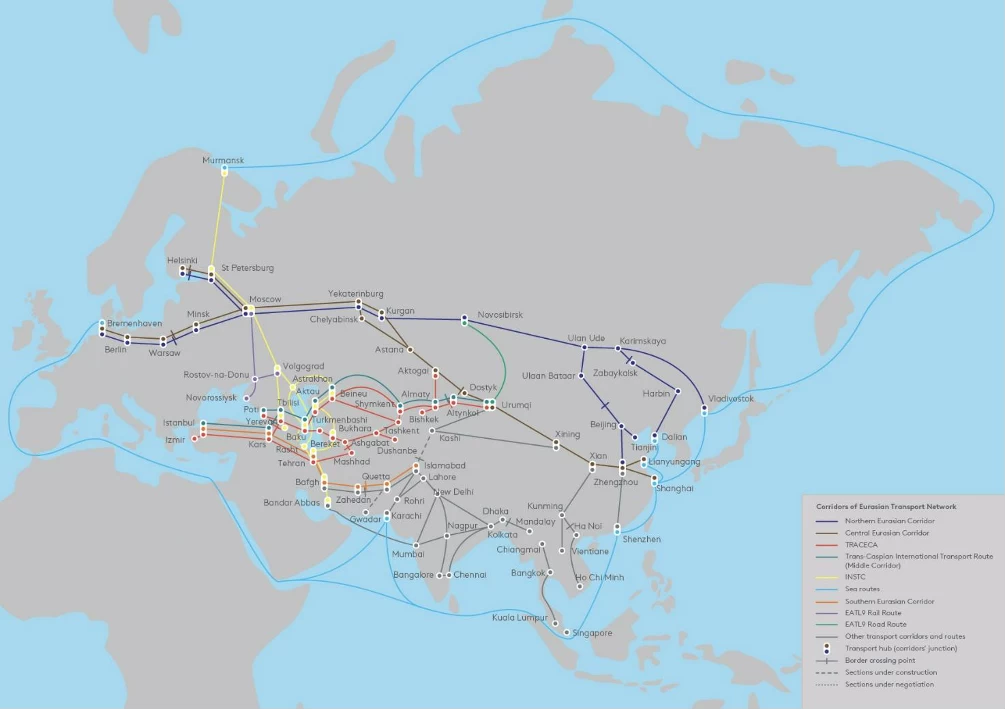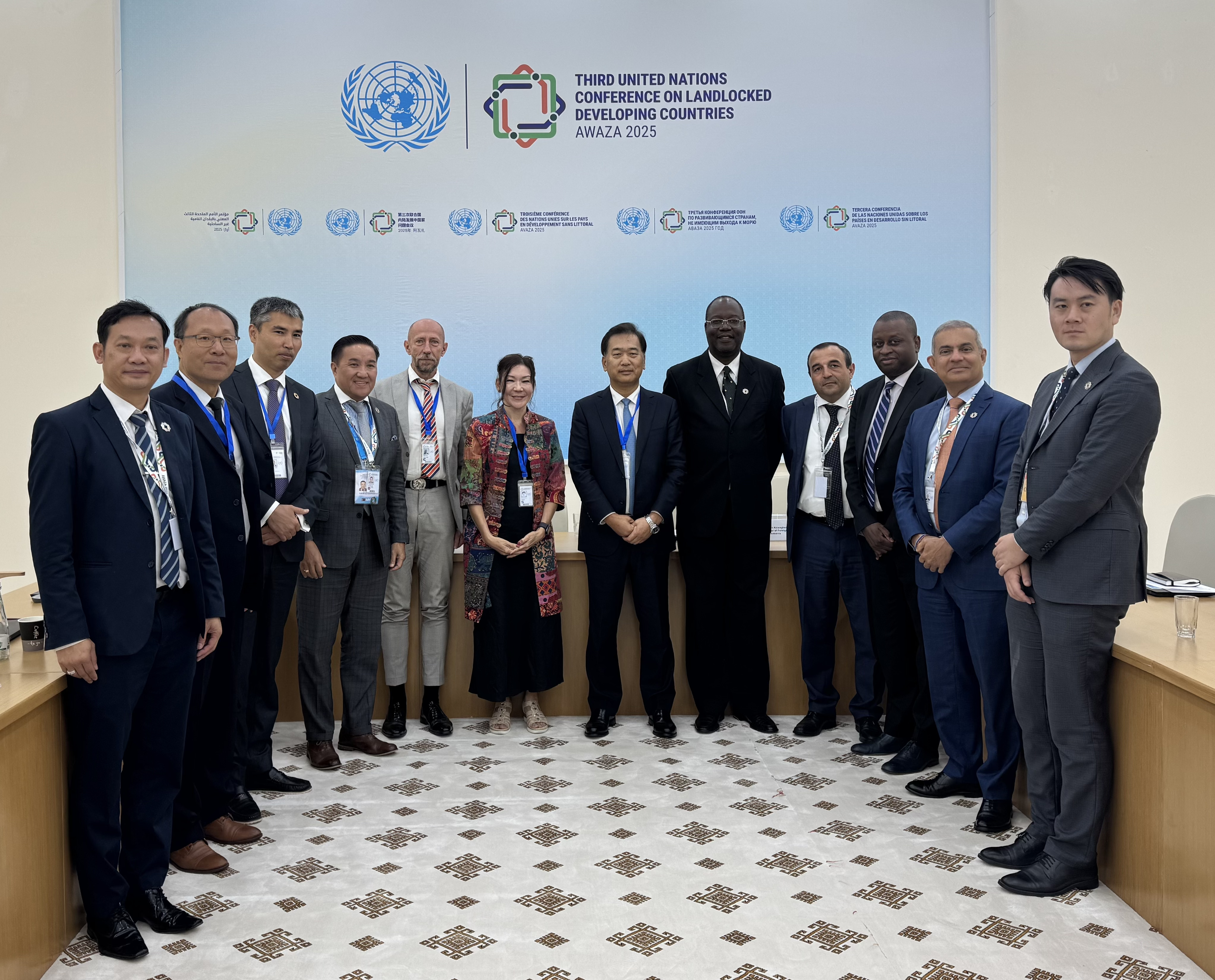The Eurasian Transport Network to contribute to the Awaza Programme of Action for Landlocked Developing Countries
The Eurasian Development Bank places particular emphasis on stimulating the development of landlocked countries, as six out of its seven member states are landlocked. The EDB participated in the Third United Nations Conference on Landlocked Countries held in Awaza, Turkmenistan, on 5–7 August 2025. The conference, attended by heads of state and government, including those from Central Asia and the South Caucasus, brought together more than 1,000 participants from over 100 countries and 50 international organisations. Accelerating the development of the Eurasian Transport Network is expected to transform Central Asia and the South Caucasus into a crossroads of trade and transit routes, thereby contributing to the priorities of the Awaza Programme of Action for Landlocked Developing Countries 2024–2034.
7 August 2025, Awaza, Turkmenistan. Pursuant to UN General Assembly Resolution 79/233, adopted on 24 December 2024, the Third UN Conference on Landlocked Countries took place in the Awaza tourist zone, Turkmenistan, from 5 to 7 August 2025. The Eurasian Development Bank (“EDB,” “Bank”) participated alongside 50 international organisations and multilateral development banks (MDBs). The conference gathered more than 1,000 participants from over 100 countries and launched the Awaza Programme of Action for Landlocked Developing Countries 2034 (“APoA”).
A group of 32 landlocked developing countries, covering an area of 15.9 million square kilometres and with a total population of 570 million, face particular economic challenges arising from their remoteness from international maritime routes and global markets. The average distance to the nearest seaport is 1,370 kilometres. Owing to their landlocked position, their level of economic development is 19% lower than it would be if they had direct access to international maritime trade.
Six of the EDB’s seven member countries are landlocked, including all Central Asian nations and Armenia in the South Caucasus. For this reason, the Bank focuses on promoting the socioeconomic development of landlocked countries and strengthening their connectivity. During the conference, the Bank expressed its support for the implementation of the APoA and reaffirmed its commitment to work with other international organisations and MDBs to unlock the economic and trade potential of landlocked countries.
The Awaza Conference featured a high-level segment as well as thematic side events and round tables on the most pressing issues for landlocked countries, including connectivity, energy, food security, trade facilitation, infrastructure development and financing for development. Participants in the high-level segment included the UN Secretary-General, the Presidents of Armenia, Kazakhstan, Tajikistan, Turkmenistan, Uzbekistan, the Prime Minister of the Kyrgyz Republic, and other heads of state and government.
The EDB took part in the thematic side event organised by UNESCAP – Connecting LLDCs to Global Trade Routes: Scaling up LLDCs and Coastal States Cooperation. At this event, the Bank presented its Eurasian Transport Network Concept and Transport Projects Observatory. Other speakers included deputy ministers from Armenia and Kazakhstan, officials from Lao PDR and Mongolia, as well as representatives of international organisations such as UNOHRLLS, UNESCAP, UNCITRAL and the International Islamic Trade Finance Corporation. The event was attended by delegates from Central Asia, Afghanistan, South Caucasus, South-East Asia and Africa.
The Eurasian Transport Network aims to establish a transport crossroads in Central Asia and the South Caucasus and to contribute to APoA priorities, in particular Priority Area 2, Trade, Trade Facilitation and Regional Integration, and Priority Area 3, Transit, Transport and Connectivity.
Eurasian Transport Network

Source: EDB
The EDB’s presentation outlined the key components of the Eurasian Transport Network:
- Harnessing network synergies – the development of a transport network to achieve up to 40% increase in freight transit through the interconnection of transport corridors and routes;
- Special focus on North–South transport corridors (the International North–South Transport Corridor, the Trans-Afghan Corridor, the Central Asia – China (XUAR) – Pakistan route, etc.), in addition to existing East-West corridors;
- Comprehensive and coordinated transport infrastructure development, with a particular emphasis on auxiliary infrastructure such as logistics centres and warehousing;
- Increased private sector participation in transport projects, particularly through public-private partnerships (PPP) and cross-border PPPs; and
- Enhancing soft infrastructure, including the harmonisation of standards and procedures, the implementation of best practices in transport infrastructure and transit, the coordination of transport corridor development, and the digitalisation of transport documents, transport technology and border crossing procedures.
Participants were also briefed on the Eurasian Transport Network Projects Observatory developed by the EDB. The observatory was presented as a tool for monitoring the development of transport corridor infrastructure and coordinating the efforts of governments and international financial institutions to improve transport connectivity in Central Asia and the South Caucasus.
Currently, Central Asian countries account for over 20% of investments in the Eurasian Transport Network. A total of 90 projects are either in progress or planned, valued at more than US $47 billion, with about 45% of this investment channelled to projects in Kazakhstan.
The APoA opens up new opportunities for MDB cooperation in Central Asia and the South Caucasus. Its Priority Area 5, Means of Implementation, urges MDBs to “bring forward actions to mobilise and provide additional financing within their mandates to support landlocked developing countries” and “deliver the scale of finance needed for infrastructure investments to improve landlocked developing countries’ connectivity.” The EDB stands ready to collaborate with other international organisations and MDBs to implement joint infrastructure projects in Central Asia and the South Caucasus.
The APoA and the EDB’s reports presented at the Awaza Conference are available at the links below:
- The Awaza Programme of Action for Landlocked Developing Countries 2024–2034;
- The Eurasian Transport Network, a report by the EDB;
- Eurasian Transport Network: Projects Observatory and Interactive Map, a working paper by the EDB.
Additional Information:
The Eurasian Development Bank (EDB) is a multilateral development bank investing in Eurasia. For more than 18 years, the Bank has worked to strengthen and expand economic ties and foster comprehensive development in its member countries. The EDB's charter capital totals US $7 billion. Its portfolio consists principally of projects with an integration effect in transport infrastructure, digital systems, green energy, agriculture, manufacturing and mechanical engineering. The Bank adheres to the UN Sustainable Development Goals and ESG principles in its operations.
The EDB Media Centre:
+7 (727) 244 40 44, ext. 4774, 2160, 3730

